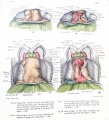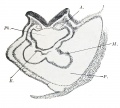Category:Embryo Klb: Difference between revisions
mNo edit summary |
mNo edit summary |
||
| (5 intermediate revisions by the same user not shown) | |||
| Line 1: | Line 1: | ||
This {{Embryology}} category shows media and pages related to the historic human embryo Klb. An early human embryo from the normal series of [[Embryology History - Franz Keibel|Keibel]] and Else. | This {{Embryology}} category shows media and pages related to the historic human embryo Klb. An early human embryo from the normal series of [[Embryology History - Franz Keibel|Keibel]] and Else. No. 3 in the Keibel and Elze Normentafel (1908), modelled by Kroemer (1903) and a partial set of tracings made by H. M. Evans is in the [[Carnegie Collection]] No. {{CE5463}}. | ||
{{Ref-Wilson1914}} | |||
:"According to present-day criteria the age of this embryo may be estimated as included in the period 18-21 days, and probably in the earliest part of this period. quote Born's estimate of the age of embryo "Klb" as 10-14 days. But if we take into account the more recently accepted criteria of age in early embryos, this age must be judged to be considerably underestimated. I shall show reason to regard embryo " Klb" as distinctly more advanced in development than embryo H3." | :"According to present-day criteria the age of this embryo may be estimated as included in the period 18-21 days, and probably in the earliest part of this period. quote Born's estimate of the age of embryo "Klb" as 10-14 days. But if we take into account the more recently accepted criteria of age in early embryos, this age must be judged to be considerably underestimated. I shall show reason to regard embryo " Klb" as distinctly more advanced in development than embryo H3." | ||
Keibel, F. and Mall, F.P. [[Book_-_Manual_of_Human_Embryology_14-2|Manual of Human Embryology II]] J. B. Lippincott Company, Philadelphia (1912) | Keibel, F. and Mall, F.P. [[Book_-_Manual_of_Human_Embryology_14-2|Manual of Human Embryology II]] J. B. Lippincott Company, Philadelphia (1912) | ||
:"Fig. 23. | :"Fig. 23. Four stages in the closure of the neural tube in human embryos possessing from 5 to 14 somites. A, embryo Klb, 5-6 somites, from Keibel u. Elze (Normentafeln); B, embryo No. 391, 7 somites, Mall collection, after Dandy; C, Eternod's embryo, 2.11 mm. long, 8 somites, after Kollmann; D, embryo 2.4 mm. long, 14 somites- estimated age 14 to 16 days. (C and D after Kollmann.) posterior ends of* the neural plate are found in the median line. In the closure of the tube it is the lateral portions of the anterior and posterior margins that unite last, and so the neuropores are found dorsal to what was originally the extreme ends of the neural" | ||
Kellicott, W.E. [[Book - Outlines of Chordate Development 6|Outlines of Chordate Development]] (1913). | Kellicott, W.E. [[Book - Outlines of Chordate Development 6|Outlines of Chordate Development]] (1913). | ||
| Line 14: | Line 16: | ||
[https://embryology.med.unsw.edu.au/embryology/index.php?search=Klb&title=Special%3ASearch&go=Go '''Search - Klb'''] | |||
==References== | |||
{{Ref-KeibelMall1912}} | |||
{{Ref-Wilson1914}} | |||
{{Ref-Davis1927}} | |||
[[Category:Human]][[Category:Franz Keibel]] | [[Category:Human]][[Category:Franz Keibel]] | ||
Latest revision as of 04:05, 11 December 2017
This Embryology category shows media and pages related to the historic human embryo Klb. An early human embryo from the normal series of Keibel and Else. No. 3 in the Keibel and Elze Normentafel (1908), modelled by Kroemer (1903) and a partial set of tracings made by H. M. Evans is in the Carnegie Collection No. Template:CE5463.
Wilson JT. Observations upon young human embryos. (1914) J Anat Physiol., 48(3): 315-51 PMID 17233002 PMC1288949
- "According to present-day criteria the age of this embryo may be estimated as included in the period 18-21 days, and probably in the earliest part of this period. quote Born's estimate of the age of embryo "Klb" as 10-14 days. But if we take into account the more recently accepted criteria of age in early embryos, this age must be judged to be considerably underestimated. I shall show reason to regard embryo " Klb" as distinctly more advanced in development than embryo H3."
Keibel, F. and Mall, F.P. Manual of Human Embryology II J. B. Lippincott Company, Philadelphia (1912)
- "Fig. 23. Four stages in the closure of the neural tube in human embryos possessing from 5 to 14 somites. A, embryo Klb, 5-6 somites, from Keibel u. Elze (Normentafeln); B, embryo No. 391, 7 somites, Mall collection, after Dandy; C, Eternod's embryo, 2.11 mm. long, 8 somites, after Kollmann; D, embryo 2.4 mm. long, 14 somites- estimated age 14 to 16 days. (C and D after Kollmann.) posterior ends of* the neural plate are found in the median line. In the closure of the tube it is the lateral portions of the anterior and posterior margins that unite last, and so the neuropores are found dorsal to what was originally the extreme ends of the neural"
Kellicott, W.E. Outlines of Chordate Development (1913).
- "Fig. 162. Young human embryos. After Keibel and Elze. A. Keibel and Elze's Embryo Klb, X 25. B. Kollmann's Embryo Bulle, X 20. For description, see text."
References
Keibel F. and Mall FP. Manual of Human Embryology II. (1912) J. B. Lippincott Company, Philadelphia.
Wilson JT. Observations upon young human embryos. (1914) J Anat Physiol., 48(3): 315-51 PMID 17233002 PMC1288949
Davis CL. Development of the human heart from its earliest appearance to the stage found in embryos of twenty paired somites. (1927) Carnegie Instn. Wash. Publ 380. 19: 245-284.
Pages in category 'Embryo Klb'
The following 5 pages are in this category, out of 5 total.
Media in category 'Embryo Klb'
The following 4 files are in this category, out of 4 total.
- Davis1927 plate02.jpg 1,357 × 1,500; 795 KB
- Keibel Mall 038-039.jpg 600 × 389; 30 KB
- Keibel Mall 2 314.jpg 760 × 1,000; 103 KB
- Keibel Mall 2 372.jpg 998 × 900; 112 KB



